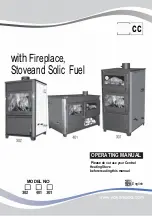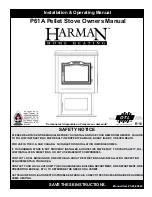
17
ASH DISPOSAL
Remove ashes when the unit has cooled. Ashes should be placed in a metal container with a tight fitting lid. The closed
container of ashes should be placed on a noncombustible floor or on the ground, well away from all combustible
materials, pending final disposal. If the ashes are disposed of by burial in soil or otherwise locally dispersed, they should
be retained in the closed container until all embers have been thoroughly cooled. The container shall not be used for
other trash or waste disposal. If combined with combustible substances, ashes and embers may ignite.
PAINTED SURFACES
Painted surfaces may be wiped down with a damp cloth. If scratches appear, or you wish to renew your paint,
contact your authorized dealer to obtain a can of suitable high-temperature paint.
GLASS - CLEANING, REMOVAL AND REPLACEMENT OF BROKEN DOOR GLASS
Cleaning - We recommend using a high quality glass cleaner. Should a buildup of creosote or carbon accumulate,
you may wish to use 000 steel wool and water to clean the glass. DO NOT use abrasive cleaners. DO NOT perform the
cleaning while the glass is HOT. In the event you need to replace the glass, Do not attempt to operate the unit with
broken glass. Replacement glass may be purchased from your U.S. Stove Pellet Burning Room Heater Dealer. If glass
is broken, follow these removal procedures: Replacement glass must be 0.197” thick tempered ceramic glass with a
working service temperature of 1400 deg. F.
1. Once the heater has cooled, remove the door from the heater.
2.
Remove the rope gasket from the door followed by the eight(8) nuts holding the glass retainer in place.
3.
While wearing gloves, carefully remove any loose pieces of glass from the door frame.
4. Replace the glass and gasket, making sure the gasket runs the full perimeter of the glass edge.
5. Re-install the retainer and eight nuts and rope gasket using high temperature silicone to adhere the gasket to
the door.
6.
Never use substitute materials for the glass.
DO NOT abuse the door glass by striking, slamming or similar trauma. Do not operate the stove with the glass removed,
cracked or broken.
SMOKE AND CO MONITORS
Burning wood naturally produces smoke and carbon monoxide(CO) emissions. CO is a poisonous gas when exposed
to elevated concentrations for extended periods of time. While the modern combustion systems in heaters drastically
reduce the amount of CO emitted out the chimney, exposure to the gases in closed or confined areas can be
dangerous. Make sure your stove gaskets and chimney joints are in good working order and sealing properly to ensure
unintended exposure. It is recommended that you use both smoke and CO monitors in areas having the potential
to generate CO.
FALL START UP
Prior to starting the first fire of the heating season, check the outside area around the exhaust and air intake
systems for obstructions. Clean and remove any fly ash from the exhaust venting system. Clean any screens on
the exhaust system and on the outside air intake pipe. Turn all of the controls on and make sure that they are
working properly. This is also a good time to give the entire stove a good cleaning throughout.
SPRING SHUTDOWN
After the last burn in the spring, remove any remaining pellets from the hopper and the auger feed system.
Scoop out the pellets and then run the auger until the hopper is empty and pellets stop flowing (this can be done
by pressing the “ON” button with the viewing door open). Vacuum out the hopper. Thoroughly clean the burn
pot, and firebox. It may be desirable to spray the inside of the cleaned hopper with an aerosol silicone spray if
your stove is in a high humidity area. The exhaust system should be thoroughly cleaned.
MAINTENANCE SCHEDULE
Use the following as a guide under average use conditions.
Gaskets around door and door glass should be inspected and repaired or replaced when necessary.
















































